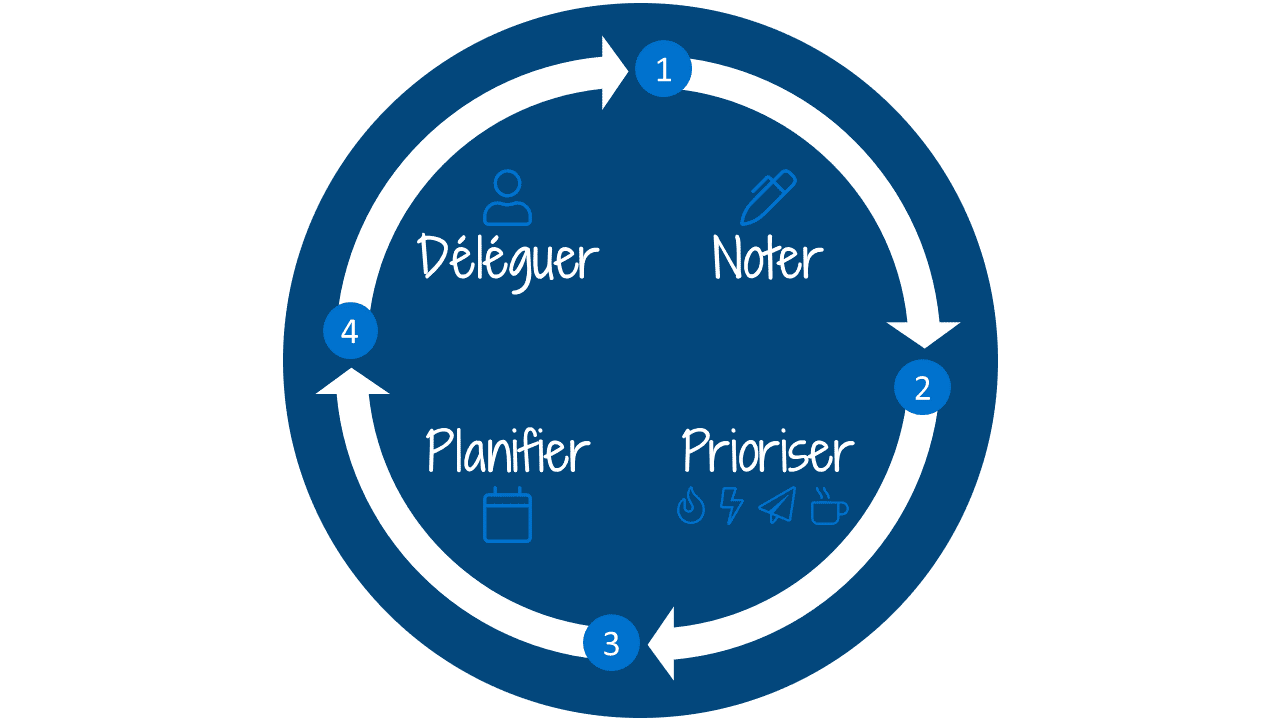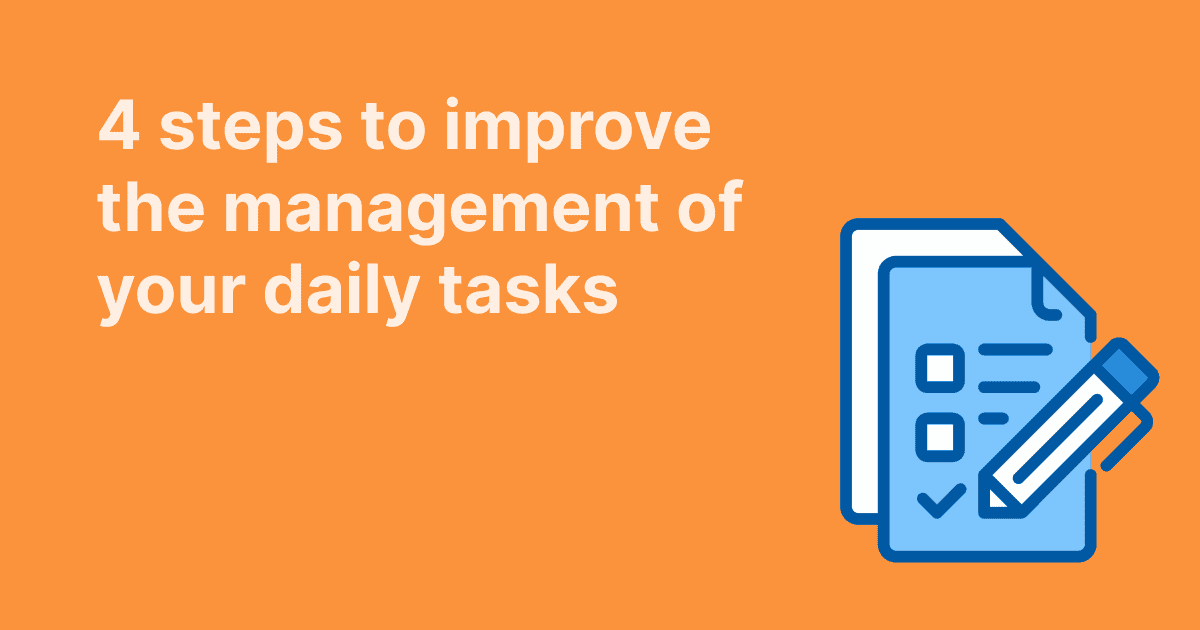When your workload becomes overwhelming, staying organized can feel impossible. How do you manage to stay positive and on top of your daily tasks when faced with a seemingly endless list of responsibilities?
It’s not always easy to know where to start. Rather than jumping in headfirst, take a moment to step back and plan. Organizing your day before tackling tasks is essential for reducing stress and boosting productivity. By breaking down your work, writing a task list, and assigning tasks, you’ll feel more in control.
But what’s the best way to do this? Follow these four simple steps to organize your day and stay on top of your workload.

Step 1: Write down all of your tasks
Before prioritizing or planning, start by listing all your tasks. Check your emails, notes, and current projects to get a complete overview. This step helps you clearly define your workload and ensures you don’t miss any day-to-day tasks.
Create a task list that breaks down all your work into smaller, manageable parts. Whether it's long-term projects or short-term deadlines, seeing everything laid out will give you a clearer picture of your responsibilities. This helps you separate smaller tasks from bigger projects and organize them accordingly.
One of the easiest ways to improve task management is by using digital tools. Many task management platforms allow you to compile tasks and even set deadlines for each one. This helps you better understand the workload and ensures that nothing gets overlooked.
Step 2: Prioritize your tasks
Prioritizing tasks is crucial for managing your time effectively. But how do you decide what’s important? Start by distinguishing between tasks that are urgent and those that are important—two terms that are often confused.
Dwight D. Eisenhower’s famous method, the Eisenhower Matrix, helps clarify this distinction. His quote, “What is important is seldom urgent, and what is urgent is seldom important,” is the foundation for this technique. The Eisenhower Matrix helps you categorize tasks into four groups:
- Urgent and Important: These tasks require immediate attention and directly contribute to your long-term goals. They should be addressed first. - Important but Not Urgent: These tasks don’t need immediate action but are essential for your personal and work-related goals. Schedule them for later. - Urgent but Not Important: These tasks need attention but don’t necessarily help you achieve your long-term projects. Delegate these whenever possible. - Not Urgent and Not Important: Tasks that neither support your goals nor need to be completed soon. These can be deferred or moved to the bottom of the list.
The urgent but not important tasks represent tasks linked to the goals of other people (such as tasks to do in the context of a collective project). Hence, you can delegate them to third parties as much as possible. Tasks that are neither urgent or important can be moved to a sort of “suggestion box.”
These tasks are not essential at the moment, as they do not have a direct influence on your long-term goals, but they should still be kept in mind. The main idea is that tasks should be frequently reviewed, and their relevance should be analyzed to see if their status is changing. This makes it easier to stay on top of things, even when faced with many responsibilities.

Knowing how to manage daily tasks requires understanding which tasks are most critical to your personal and organizational goals. The better you become at sorting through priorities, the easier it will be to maintain focus and complete tasks efficiently.
Step 3: Plan and schedule your tasks
Once you’ve identified which tasks are most important, the next step is to plan and schedule them. This involves setting clear due dates and organizing your tasks over days, weeks, or months, depending on the timeline for completion.
For all important tasks, try to set a planning date according to your time schedule. Use a project management tool or task management platforms to break down big projects into smaller tasks that can be completed over time. Start by organizing your week and allocating specific days to specific tasks. Having a clear schedule allows you to pace yourself and stay focused on what needs to be done each day.
Make sure to note both the due date and planning date—the planning date is when you’ll work on the task, while the due date is the final deadline. This approach helps with time management and ensures that you’re not rushing at the last minute.
In your work routine, you probably have tasks that recur. Recurring tasks can also be planned more efficiently by using task management tools that allow you to set reminders for daily tasks or long-term projects. Setting recurring tasks will help you manage your workflow smoothly.
A well-structured schedule not only helps you stay on top of tasks but also increases productivity by reducing last-minute stress. By assigning tasks to specific time slots, you can ensure that each one gets the attention it deserves.

Step 4: Delegate and collaborate
In your daily life, you are likely to collaborate and work in teams. And sometimes, the best way to manage your workload is by delegating tasks. Urgent but not important tasks, for example, are perfect for delegation. These may be tasks that contribute to a project’s progress but aren’t critical to your own responsibilities.
When you delegate tasks to team members, be sure to communicate clearly. Assign the task, set a due date, and follow up to ensure it’s completed on time. Collaboration tools can make delegation easier by allowing you to share tasks in real time and track progress. Make use of project management software to keep everyone aligned and working toward shared goals.
Delegating frees up your time for the tasks that require your personal attention, while also empowering your team members to take on more responsibility.
Stay on top of your daily task list
Following these steps allows you to stay organized and manage your time effectively. Avoid overloading yourself by overestimating how much you can complete in a single day. Instead, set clear, manageable goals and focus on completing tasks one by one. At the end of each day, take a moment to review your progress.
Were the tasks you planned completed? If so, it means you’ve set reasonable goals. If not, consider reducing the number of tasks on your daily task list to ensure you don’t overwhelm yourself. This regular review will help you refine your approach and increase productivity over time.
Choosing the right task management tools
The good news is that you don’t have to do this all on your own. There are many task management tools and project management software available that can help you organize your tasks. These tools provide pre-made templates for task organization, making it easier to track progress, set deadlines, and ensure tasks are completed on time.
Look for a project management tool that fits your working style—something flexible and easy to use. These tools will allow you to assign tasks, set priorities, manage deadlines, and track progress in real time, helping you and your team stay on top of everything.
Conclusion: Take control of your time
By following these four steps—writing down tasks, prioritizing, planning, and delegating—you’ll find it much easier to manage your workload. Staying organized helps you avoid unnecessary stress and allows you to stay focused on your goals. Whether it’s managing day-to-day responsibilities or planning for long-term projects, using the right tools and techniques will keep you productive. Want to improve your task management process? Discover how WEDO can help you organize your work more effectively with our customizable tools for real-time collaboration.
Schedule a live demo today and start optimizing your workflow!



